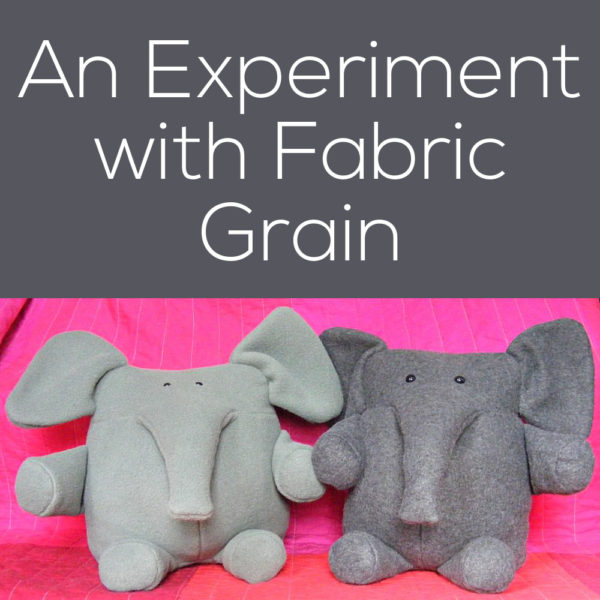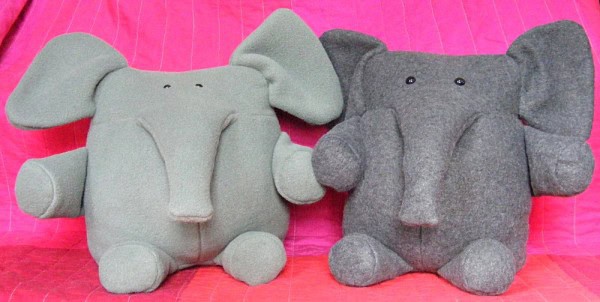
I talked about fabric grain in this video about working with polar fleece. Fleece is stretchy across the fabric (when you stretch from selvedge to selvedge) and much less stretchy when you stretch the length of the fabric (along the selvedge). Watch the video to see that stretch in action.
But what difference does the grain of the fabric make when you’re sewing softies?
I thought I’d make two softies – one with the pieces cut on the grainline indicated, and the other cut the exact opposite way.
 I made both of these elephants from the same pattern. I made them both from similar weight polar fleece. I stuffed them with the same amount of stuffing. The dark grey ones has larger eyes, but other than that they’re identical.
I made both of these elephants from the same pattern. I made them both from similar weight polar fleece. I stuffed them with the same amount of stuffing. The dark grey ones has larger eyes, but other than that they’re identical.
Except for the grain of the fabric.
I made the light grey one exactly as the pattern indicated – with the stretch running across his body. I wanted to emphasize his fatness. 🙂
I made the dark grey one with the grain running opposite of what the pattern indicated – so the stretch was running up and down his body.
Can you see the difference?
Jo said the light grey elephant looks fat, and the dark grey elephant just looks bloated – which I thought was pretty funny. 🙂
The dark grey elephant is clearly taller – that up and down stretch made a big difference there. And there’s a subtle difference in the seam between his face and his body. It’s a tiny bit more defined, because his body bulges a bit more above and below it. It’s also clear in person that the tummy of the light grey elephant bulges out more than the dark grey.
The dark grey elephant doesn’t look bad. And if you make a softie (especially a big bulky one like this) with all the grainlines cut wrong you won’t have a disaster on your hands. But your finished softie will look subtly different from the one on the pattern cover – and the results will be much more pronounced on a softie with skinnier, more precisely shaped parts.
So now you know!
Any other fabric mysteries you’d like me to tackle? Leave a comment or send me an email.
Oh – and if you want to make that elephant yourself – you can get the pattern here. It comes with a pattern for her little mouse friend too. 🙂
Happy sewing!





It would be great to have a tut on long fur. Like how to pull out the fur stuck at the seams – or avoiding it from happening all together.
That being said, you may already have touched on this. I have not checked your entire web-site. But I will!!
I do have a video all about working with long fur – including the best way to cut it and how to sew it so you don’t have to pick it out of the seams later. (I hate doing that.) You can watch the video here. http://wendigratz.wpengine.com/2013/01/video-intraux-to-faux-fur.html 🙂
Thank you for the clear explanation. I understand the effect because I do soft sculpture dolls from
knit fabric and don’t want hands and arms or legs that look way too fat for the proportions of the
doll. just didn’t know how to explain this to anyone who wanted to be shown how to do soft
sculpture. love your site and patterns , wish I had found it when my grandaughters were smaller,
they are all teens now.
I’m glad it was helpful. 🙂
Hi Wendi!
Thanks for the thought! I still have a doubt though. I sew some diapers for my own kids and making diapers works with different types of fabric. I have patterns, but it never indicates which way to cut. Can i just cut anyway i like? I work with PUL, cotton woven and sometimes minky. Any of these fabrics that i should stick with the correct grain of fabric??
I would try to always line up the grain of the fabric – better safe than sorry. 🙂 I’ve never made diapers before, but I would line up the grain so it goes the length of the diaper. Good luck!
I am looking to make a stuffed animal with horizontal stripes and the fabric that I would love to use has vertical stripes. It’s a soft minky fabric. Do you think it would make much difference? It says “Stretch: Moderate Horizontal Stretch |Moderate Bias Stretch.”
You can definitely still use it – just be aware that your finished softie might look a tiny bit different from the reference photos – maybe a bit taller and skinnier.
Oh my! What a simple, understandable way of explaining the grain. I’ve been trying to “get this” for years. Now, I’m off to start your Munchie pattern. THANK you ❤️ Laurie